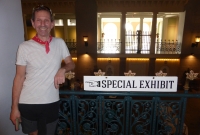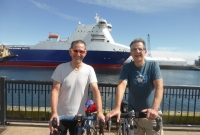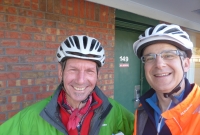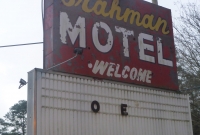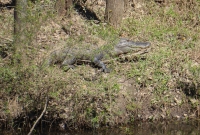Since the first day of our ride we’d been struggling to get to New Orleans in time for Mardi Gras. So I don’t know why we were surprised when the last 40 miles did everything it could to stop us, including a energy-sapping headwind, terrifying traffic and a falling out over Jayne Mansfield. Yes, you read that right.
I guess the last few weeks have taken their toll on us both physically and mentally and a night spent sleeping in a squelching swamp hadn’t helped. With rain threatening we decided to get up and go as quickly as possible and hit the road to the Big Easy, where we hoped some downtime and hedonism would revitalise our spirits.
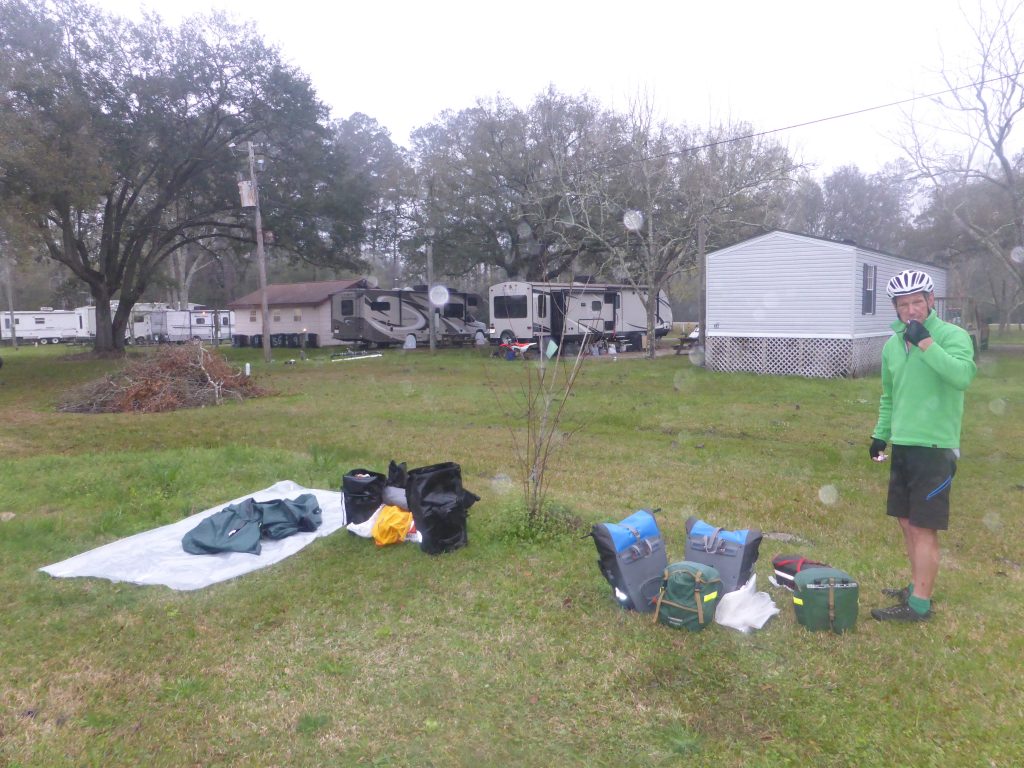
Fortunately the plastic bags we’d transported our bikes in on the outbound flight from the UK, were now doubling as ground sheets and they’d done their job well on the soggy ground. The inner tent was dry even if the fly sheets weren’t. Somehow, despite being surrounded by mud, Terry looked pristine – not a trace of dirt anywhere – meanwhile I was caked in the stuff – all over my shoes, my tent and my panniers. I guess that’s called having fun in the Bayou – the muddier you get then the more fun you’re having.

Fortunately the rain held off, but as we pulled out onto the virtually deserted 90 a thick morning fog had formed and we needed to switch on all our lights. We stopped off at the local gas station to grab a makeshift breakfast of hard-boiled eggs, biscuits and bananas and I tried out a local delicacy – a boudon sausage made with crawfish and shrimp.
“No wonder you have problems with your stomach!’” was Terry’s only remark as I peeled back the tinfoil wrapper and tucked in. The sausage was delicious. The man behind the counter told us they had a lot of cyclists coming through that way and an elderly couple were just a day ahead of us. He also told us of a time a group of women had come through – all on roller blades: “You should have seen their legs!” he smiled. I got the impression he wished they’d stayed around, but it seems they got their skates on.
“We immediately entered a mysterious landscape surrounded on each side by mile upon mile of reed beds and marshes”.
So we weren’t the only ones who’d cycled (or skated) this eastern route into the city and so far it had been pretty straightforward. But his parting comment mirrored a warning given to us by Geoff, the owner of the RV site – we should be very careful cycling through the East side of New Orleans: “When you get to that first set of traffic lights don’t stop,” he warned. “Just keep going.”
Continuing along the Chef Menteur Highway we crossed the Pearl River and were in our fourth state – Louisiana. We immediately entered a mysterious landscape surrounded on each side by mile upon mile of reed beds and marshes, which looked particularly atmospheric in the morning murk. We could hear there was a lot of birdlife around, but in this poor visibility it was a struggle to see where the songs were coming from.
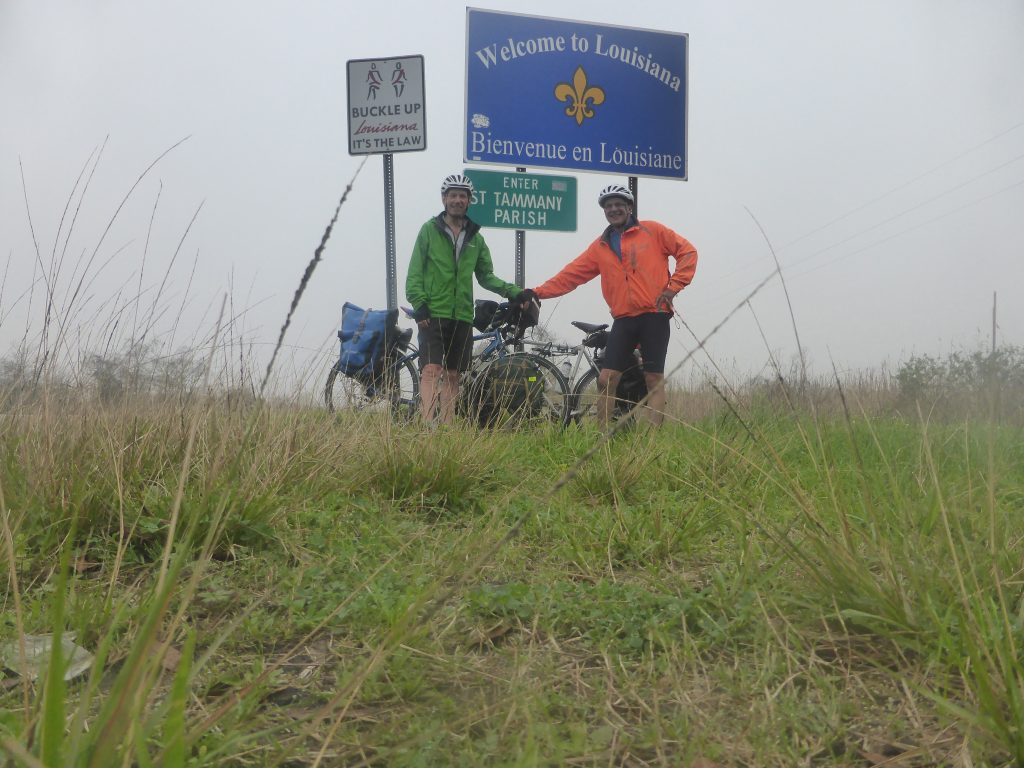
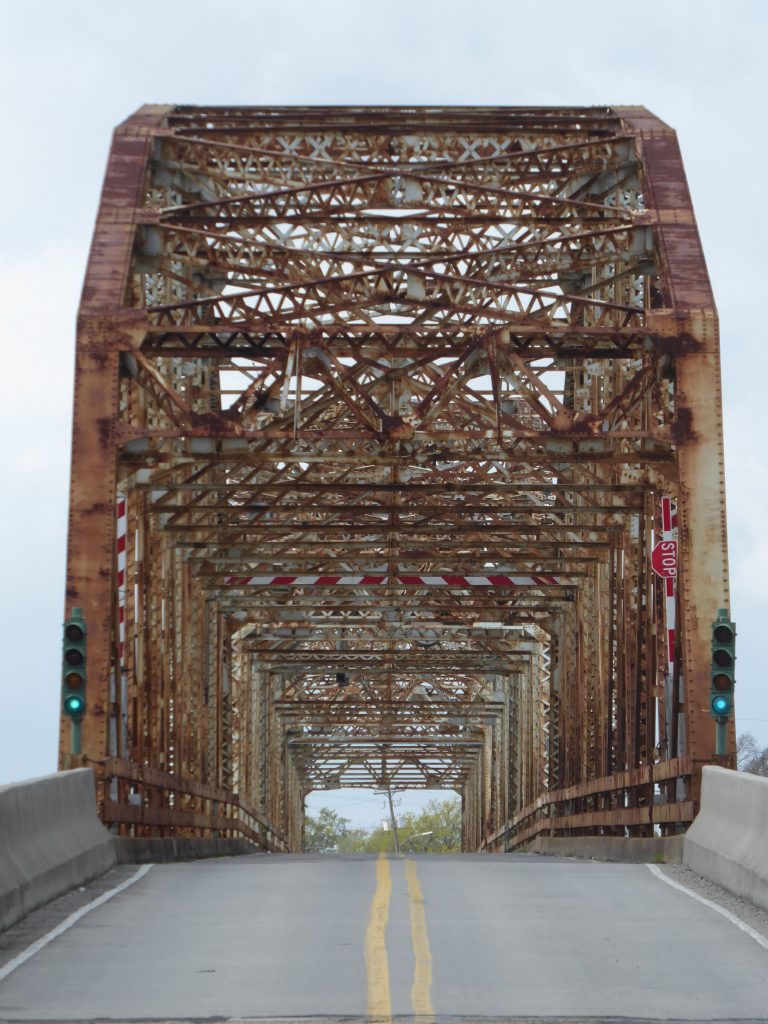
A series of rusty iron girder bridges transported us over the various tributaries of the Old Pearl River. Then we followed a left hand bend at White Kitchen and climbed a vast concrete bridge to take us over The Rigolets strait which connects the vast Lake Pontchartrain to Lake Borgne and then out into the Gulf of Mexico. From the top of the bridge we were rewarded with views of Fort Pike, built in 1819 to protect New Orleans and the coast from invasion, primarily from the British. Fortunately for us the guns had long fallen silent and we pedalled past unnoticed.
“We had our first falling out on the Southern Tier over Jayne Mansfield”.
As we descended the bridge the fog just seem to disappear, but as we rode through the Bayou Sauvage National Wildlife Reserve a beastly westerly wind whipped up in its place and hit us full in the face. It was to be our constant companion all the way into the city – at some points our forward speed fell to just 7mph. If we went any slower Mardis Gras would all be packed away for another year before we even reached the outskirts.
“It isn’t easy riding something with the profile of a small shed!” Terry remarked as we wobbled and wibbled down the road. The panniers took the full impact of the wind, twisting the handlebars wildly. At one point our ‘sheds’ even collided – a lapse of concentration on my part.
We had our first falling out on the Southern Tier over Jayne Mansfield. Well not her exactly, more about the nature of her death. Coming down the road we came upon a ‘shrine’ marking where she had been killed in a car crash aged just 34, on the 29th June 1967.
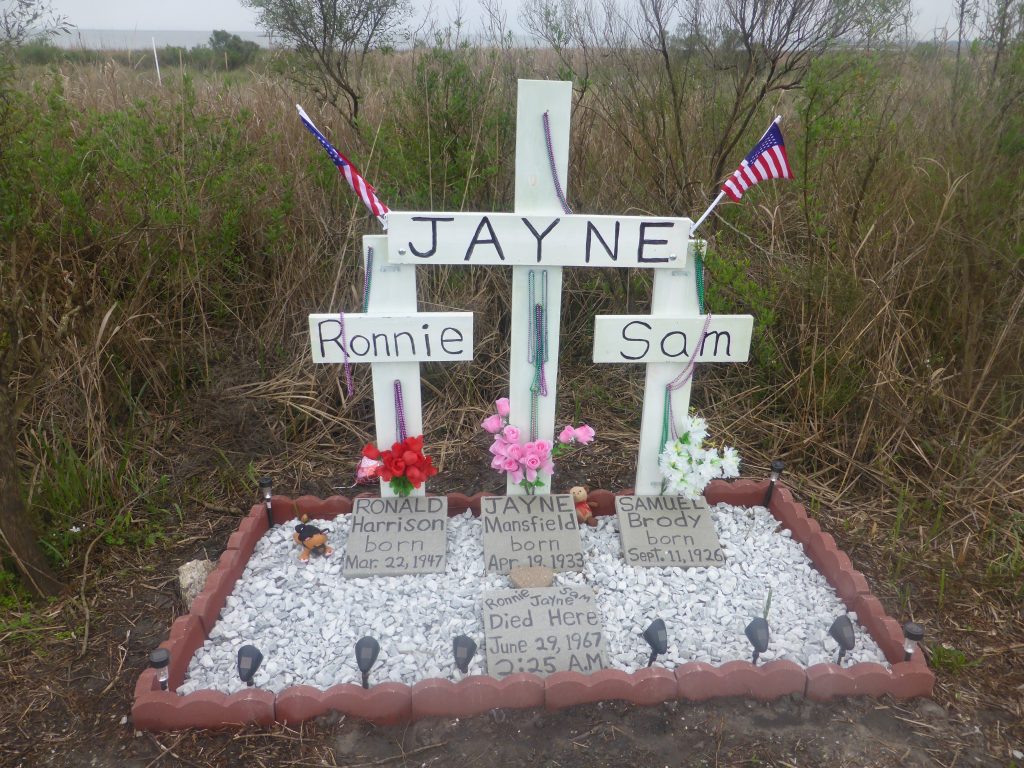
Not noticing Terry was setting up a photo, I wheeled my bike forward to take a closer look and stood right in front of his shot. I then compounded this thoughtlessness by lingering there and looking up the details of her sad demise on wikipedia. It turns out she’d been on her way to New Orleans from an engagement in Biloxi, had just crossed the bridge over The Rigolets and at 2.25am crashed at high speed into the rear of a tractor-trailer. Mansfield, her driver and her attorney, who were all in the front seat of the Buick Electra, died instantly. Mansfield’s three children, who were in the back seat, survived.
It was pretty grisly stuff and I admit it didn’t do much to lift our mood, but Terry’s reaction was short and sharp: ”Do you want to get to New Orleans or not?” he asked and while I scrolled down the page to find out more he shot off on his bike like a man possessed – cutting through the wind as if it wasn’t even there. He wasn’t a happy man.
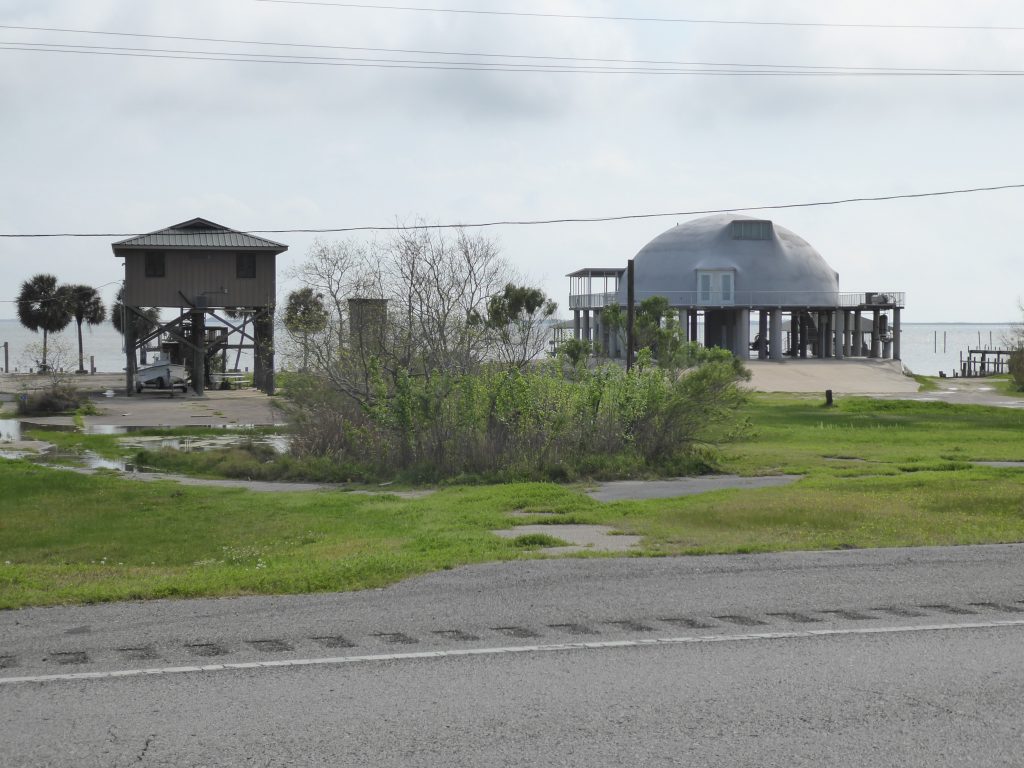
Try as I might I couldn’t catch him – with each bend in the road he seemed to get further away from me as I slogged on against the impossible barrier of the wind. Occasionally the siting of a pelican, or a white ibis would lesson the pain in my legs and I passed the time noticing how many of the houses, perching on stilts along the route, had a ‘2’ following their name. It was probably a fair guess the orginal dwelling had been a victim of Katrina.
I eventually caught up with Terry sitting by a bridge watching pelicans and diving birds and eating a banana. I apologised. I hadn’t done much wrong, but I’d been insensitive and it probably wasn’t the first time I’d got on his nerves by rabbiting more than pedalling. Besides which we were both tired, the wind was mind-numbing and it was that classic time when small niggles start emerging and growing legs. I asked him how he cut through the wind so efficiently – I had found it absolutely impossible to catch him however hard I tried.
“To be honest I think it was just bloody mindedness,” he said. For me it was another reminder of how fit he was and how I must hold him back every day of the ride.
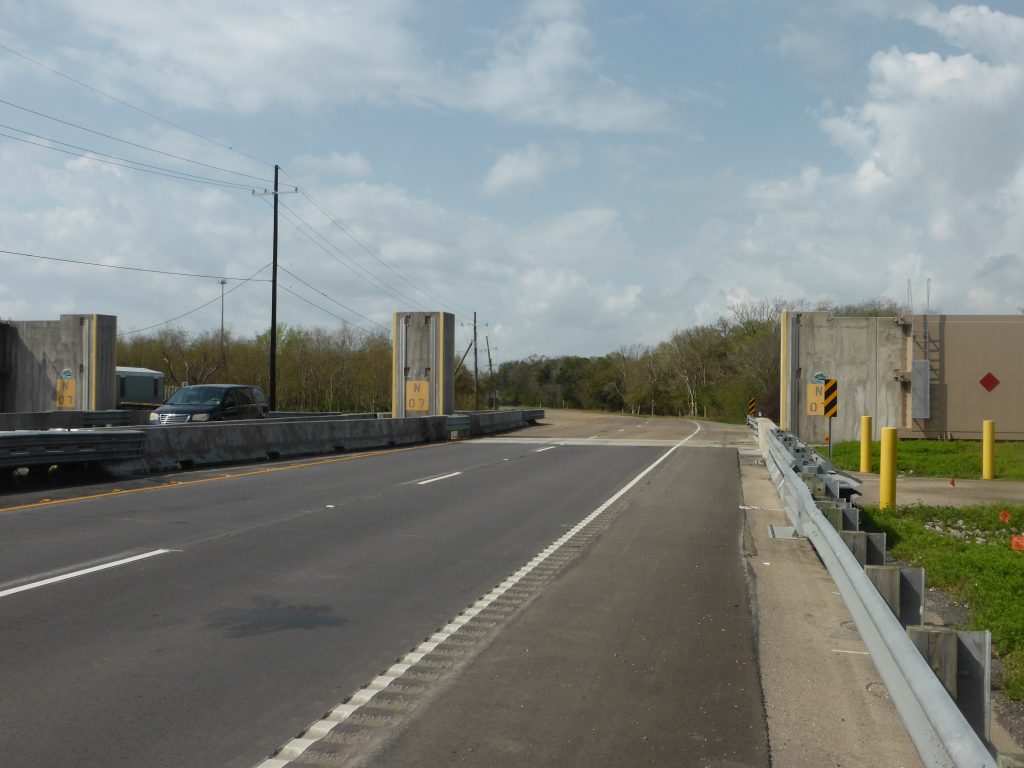

We saw more reminders of Katrina as we progressed through the levee gates that surround the city. Boats washed up in trees and still abandoned, businesses in ruins, an old people’s complex on the east side now nothing more than a sign and a scattering of brick foundations marking where the residential blocks had once stood and people had made their lives.
“We ended up stopping at virtually every red light for miles and we were moving so slowly even an old lady with a zimmer frame could have outrun us”.
Soon we were in the east side and as the first set of traffic lights turned red we stopped. Looking around we expected to be lynched by a howling mob, desperate to get their hands on our Clif bars, sweaty socks and outdated mobile phones. And of course nothing happened. In fact we ended up stopping at virtually every red light for miles and we were moving so slowly even an old lady with a zimmer frame could have outrun us.
The most threatening thing that happen was a couple of youths yelling at us to give them our water. Poor kids, addicted to H20 at such a young age. In truth, the mostly Asian population seemed far more concerned with getting lunch at the local Vietnamese restaurant than bothering two smelly Brits, one caked in Mississippi mud.
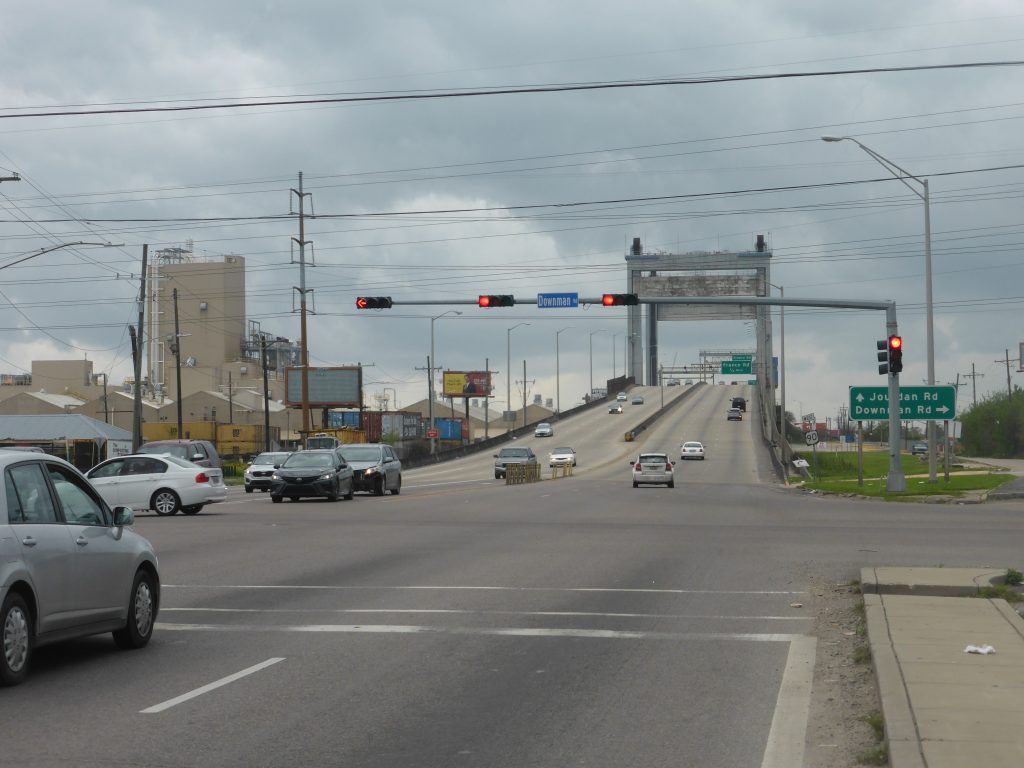
Coming into the city proper the cycle shoulder disappeared as the car lanes and intensity of the traffic grew. We eventually had to follow the 90 over the Mississippi – three lanes of traffic and a narrow shoulder littered with shredded tyres, nuts, bolts and other general detritus. Best of all it was disected every few yards by drain gratings with gaps so large they’d swallow your wheels, so you were forced to weave in and out of the traffic. It was a hairy moment, but eventually the bike lane reappeared and we cut through the Seventh Ward to the French Quarter and towards Canal Street.
The city was in full party mode – a young lad in a bright green and white uniform clutched his trombone on the way to a parade, bands played in the streets, party-goers walked in front of us wearing Venetian masks and outlandish costumes while everyone seemed to be wearing brightly coloured beads and trinkets around their necks.
“Just an hour or so earlier we had been cycling through the bayou backwaters with only the birds for company. This was an assault on the senses”.
An excited couple were having a guided tour in a rickshaw. Sirens sounded across the city and music seemed to blast from every house and car. Purple green and gold flags and rosettes, the colours of Mardi Gras, hung from balconies. A man in a floppy brown suit sat on a mustard coloured bike, seemingly balanced on its front wheel alone. A jazz band were setting up on the roadside with their instruments. It was hard to take it all in. Just an hour or so earlier we had been cycling through the bayou backwaters with only the birds for company. This was an assault on the senses.
We arrived at the Marriott Hotel on Canal Street which seemed to be having a party of its own. A radio station had set up in the entrance to the underground carpark and was entertaining the crowds, street sellers gathered outside selling souvenirs. It seemed everyone in the expansive foyer was wearing fancy dress and no-one batted an eyelid as we pushed our heavily laden touring bikes through the lobby and towards reception.
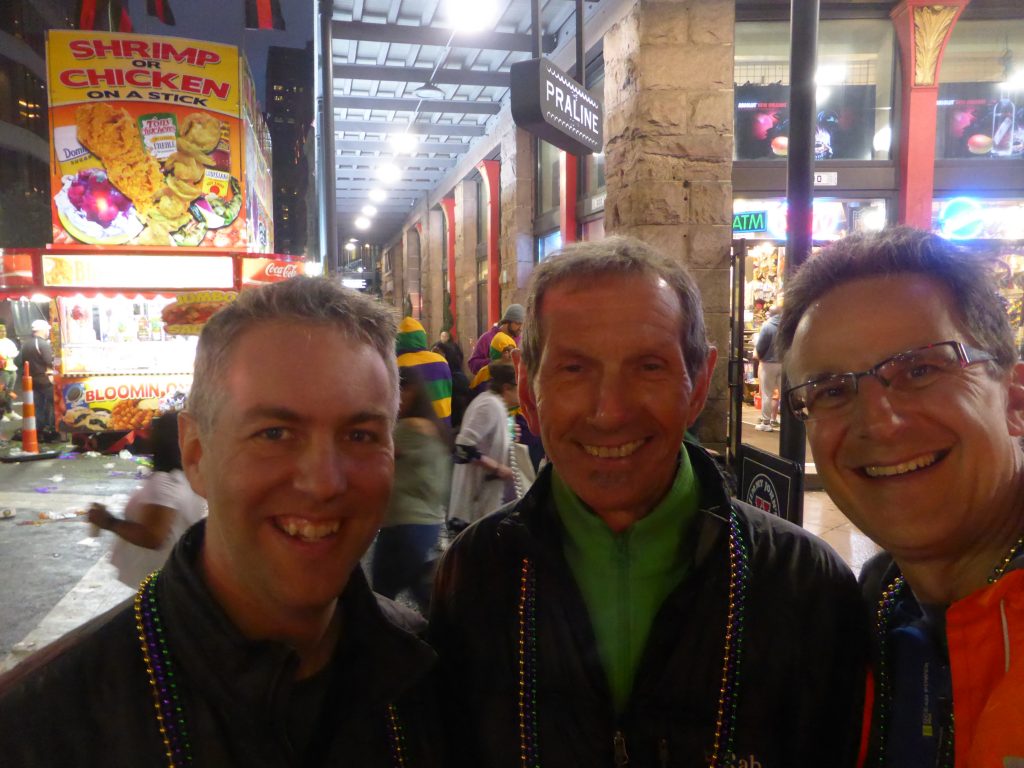
Mike Evans, our good friend who we’d met on the TransAm, had flown down from Chicago to greet us and while we waited for our room to be ready we caught up over beers, fried green tomatoes and seafood. At one point we’d hoped Mike would be joining us for part of the ride, but with a young daughter and a new business he was a busy man so the compromise was to spend a few days in New Orleans with us – and we couldn’t wait to join the party.
With Mike kindly upgrading us to a brilliant corner room with great views of the city below us we promptly filled it with bikes and wet clothing and then hit the town to watch our first parade – Bacchus. The Krewe of Bacchus, a New Orleans Mardis Gras social organisation, has been putting on parades as part of the annual celebrations since 1969. It was the first Krewe to have celebrities appear as part of the parade and its ranks have been joined by Kirk Douglas, William Shatner and Bob Hope, among many others.
There were thousands of people thronging the streets, most packed onto the sidewalks, but others in stands costing up to $95 a seat. Many had ladders with boxes on top where children could sit and get the best possible view. Many of the spectators were in costumes and finery with some already worse for wear and barely able to walk over the debris left behind from that afternoon’s parade. Beaded necklaces dangled from almost every branch on every tree and above us excited crowds gathered on ornate ironwork balconies, dancing and hoping to catch the first glimpse of the on-coming floats and marchers.
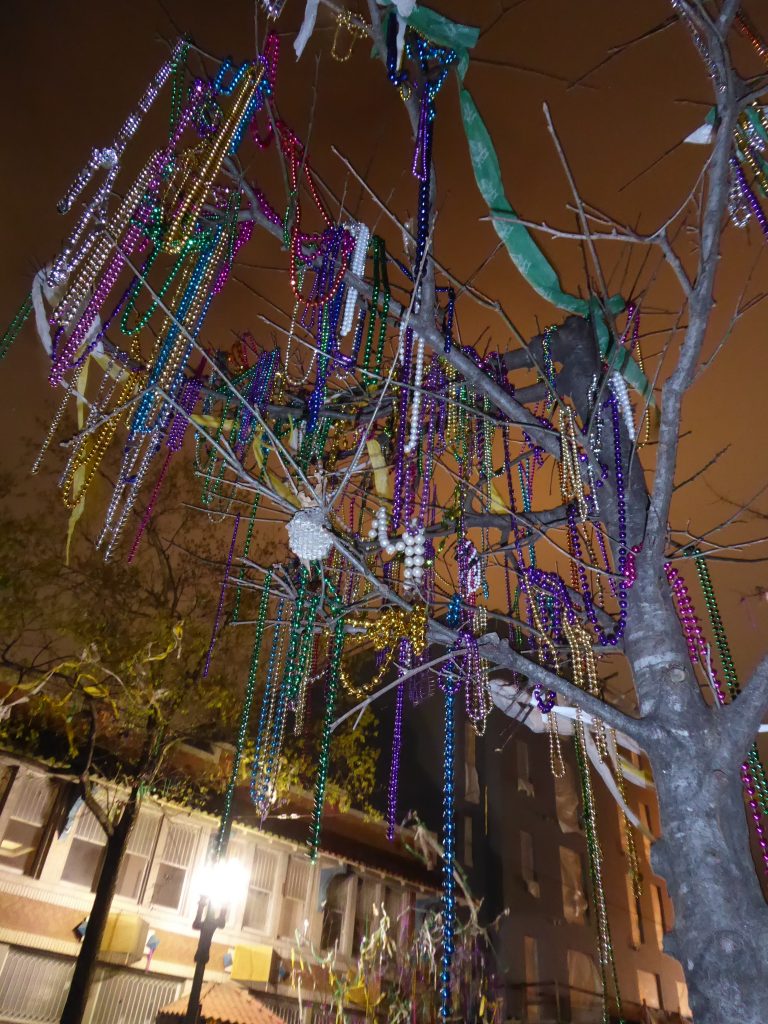
Realising we would have to wait for hours for the followers of the God of Wine to pass through Canal Street we walked through the crowds and joined the madness further up the route. It was a bizarre scene, at once fascinating and spectacular, but at the same time oddly disturbing.
Incredibly detailed but rather gaudy floats populated by scores of mainly men in face masks hurled beads, cups, trinkets, flashing swords and a whole variety of other junk at the excited crowds, who reacted as if they were being thrown dollar bills or gold bullion rather than a load of plastic from China. The onlookers just couldn’t get enough of the stuff, particularly the beads with some wearing great clumps of them around their necks.
Occasionally a trinket would hit you in the face – you had to keep your wits about you – as the ‘goodies’ rained down from above, or arced through the sky trying to catch an outstretched hand on one of the balconies. If you can imagine walking through the Factory Shop back home in fancy dress while the staff hurled all the Made in China cheap party gifts at you, then you are somewhere close to picturing the scene.
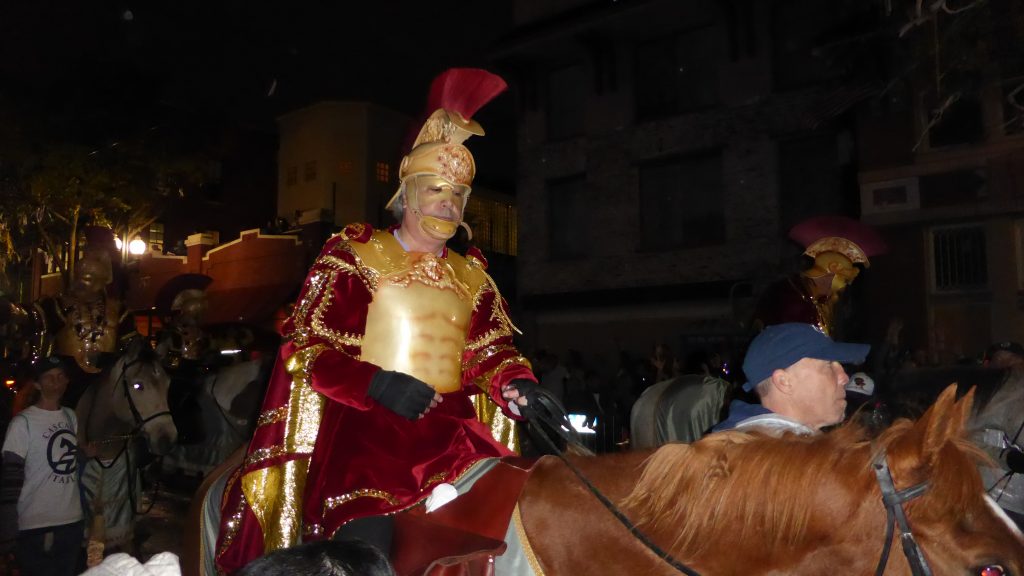
Once the Bacchus Krewe on the floats had emptied a plastic bag of its toot, that too was thrown down into the street to join the sea of litter left behind by the parade as it weaved its slow path through the city. And this was only one parade of scores that had been taking place in New Orleans – and in many other places – over the past few weeks. As Brits more used to traditional carnivals with floats decorated by the local scouts or rotary club, it was hard to get your head around.
This was excess writ large and the crowds were loving it as they called and reached out for ever more stuff, much of which fell into the gutter and was lost underfoot. We were passed by Roman soldiers on horses, marching bands wearing white-plumed helmets with so many sousaphone players it was hard to count them all and a enormous alligator, the Bacchagator, which is an annual feature of the Bacchus extravaganza.
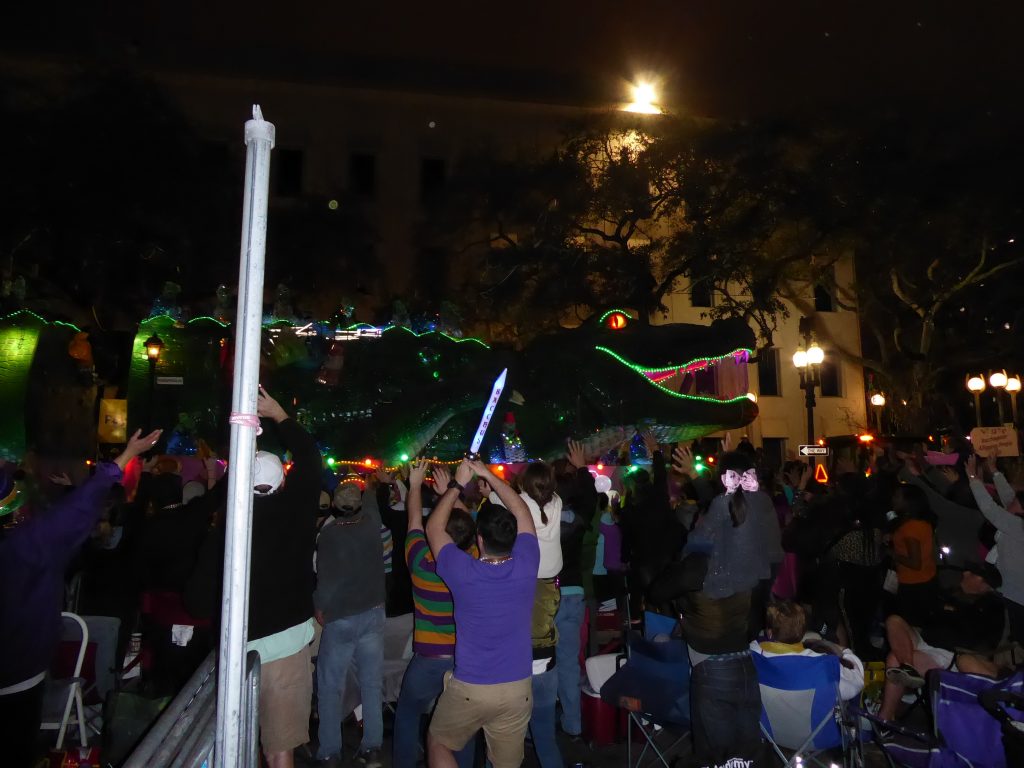
After watching the parade for an hour or so the cold and hunger were biting so we retired to Luke restuarant in Saint Charles Avenue for some exquisite food including fried sprouts and crunchy rice and got a potted history of Mardis Gras, the krewes and the history of New Orleans, from Mike’s friend David. It turned out the members of each krewe paid fees to cover the parades, which in the case of Bacchus could run into thousands of dollars.
Somehow we couldn’t help thinking that the British versions, while far less spectacular, did at least seem to have more of a charitable theme with people throwning coins at the floats and into the tins, rather than those on the floats chucking stuff the other way – although some of the different krewes do raise money for good causes.

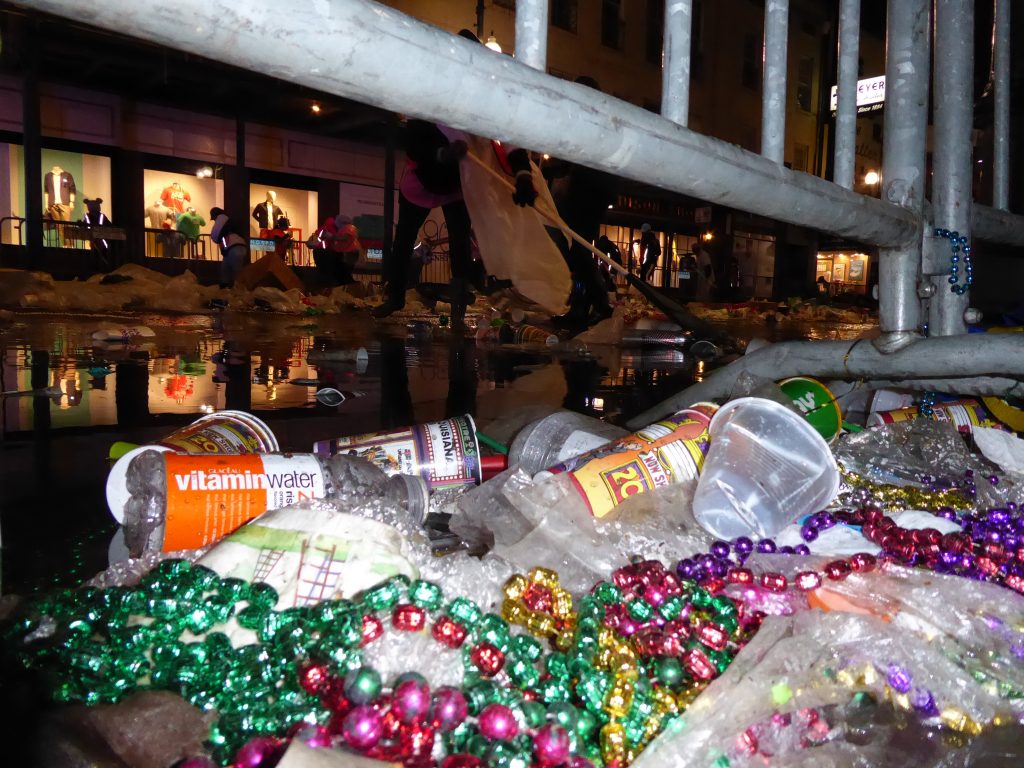
Our sense of uneasyness continued on the way back to the hotel. There were hundreds of workers alongside refuse trucks and mechanical diggers shovelling, hosing and clearing it all to prepare the streets for the following morning. The piles of plastic waste were staggering and shocking. While back in the UK we’d recently introduced the plastic bag charge in a bid to reduce single use plastics, here it was being thrown away an industrial scale.
As far as we were aware there was no recycling policy in place, which meant nearly all of it, including thousands of sets of beads that a moment ago the crowds were desperate to have, would be ploughed into landfill.
Returning to the luxury of the Marriot we tried to assimulate our new surroundings after weeks of ramen noodles, laundrettes and RV sites. Looking out of the window on the traffic below it’s liked it never happened. “Shame it did, in my humble opinion,” said Terry.
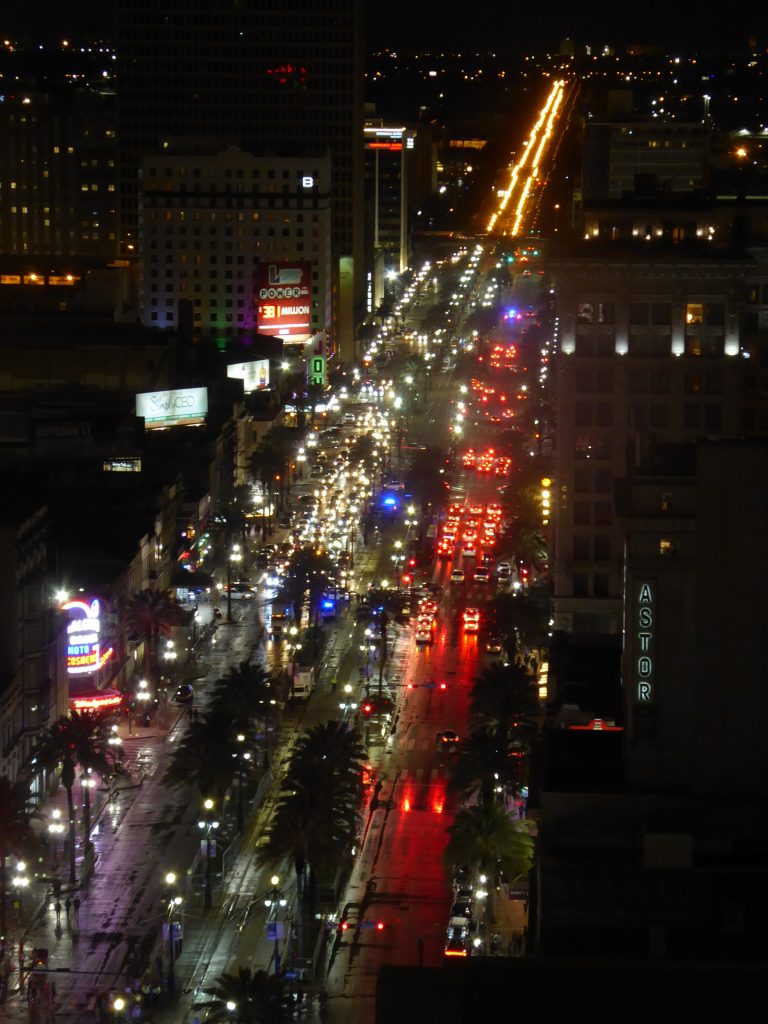
It was hard not to agree. It had been an incredible night, but while our minds were blown at the spectacle, you couldn’t ignore the environmental headache it was creating. And no-one bar Mike, Terry and I really seemed to care.
Today’s miles: 42.22 (average speed 9mph!)
Total miles since Anastasia State Park: 739.60


